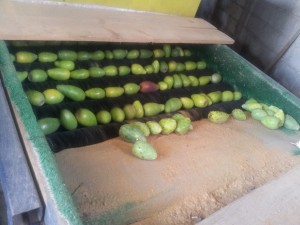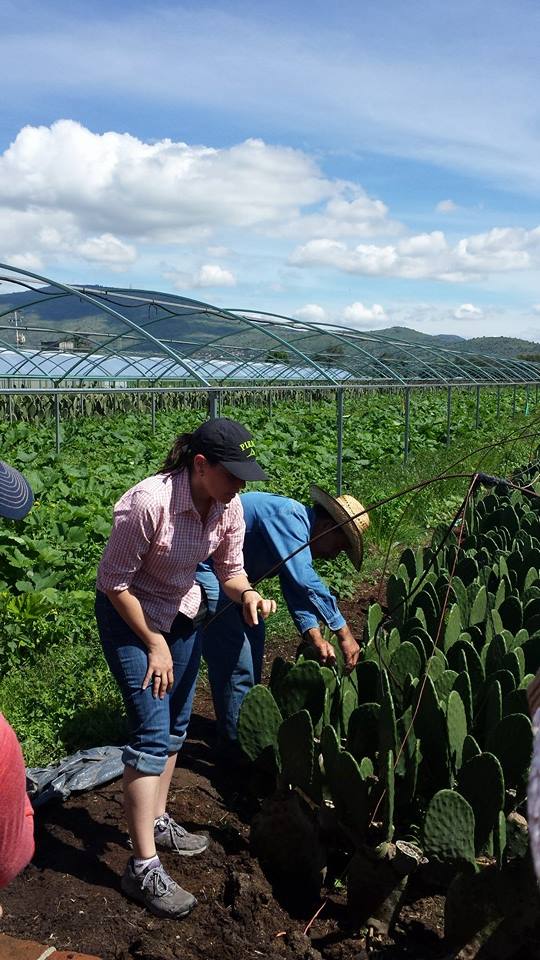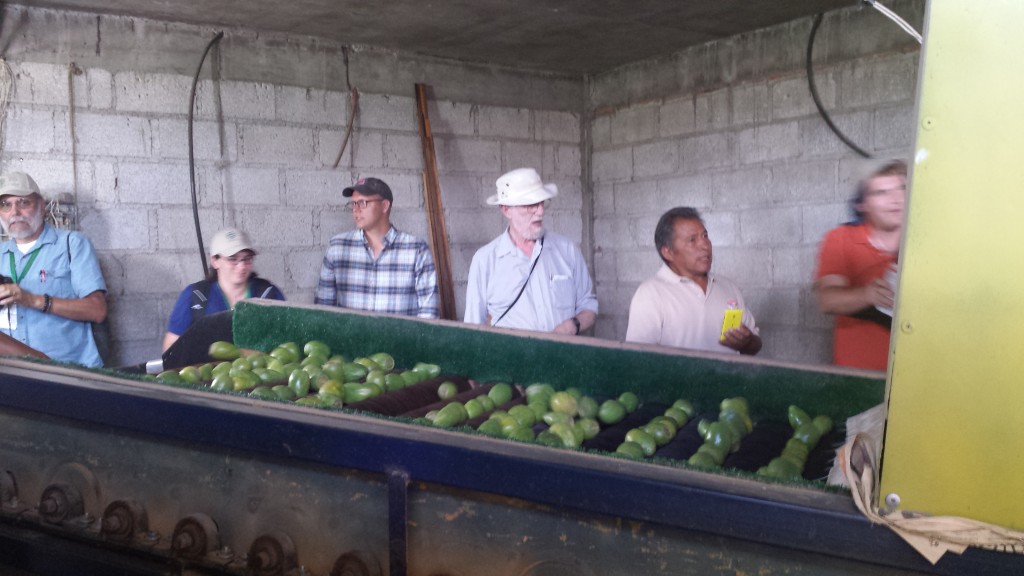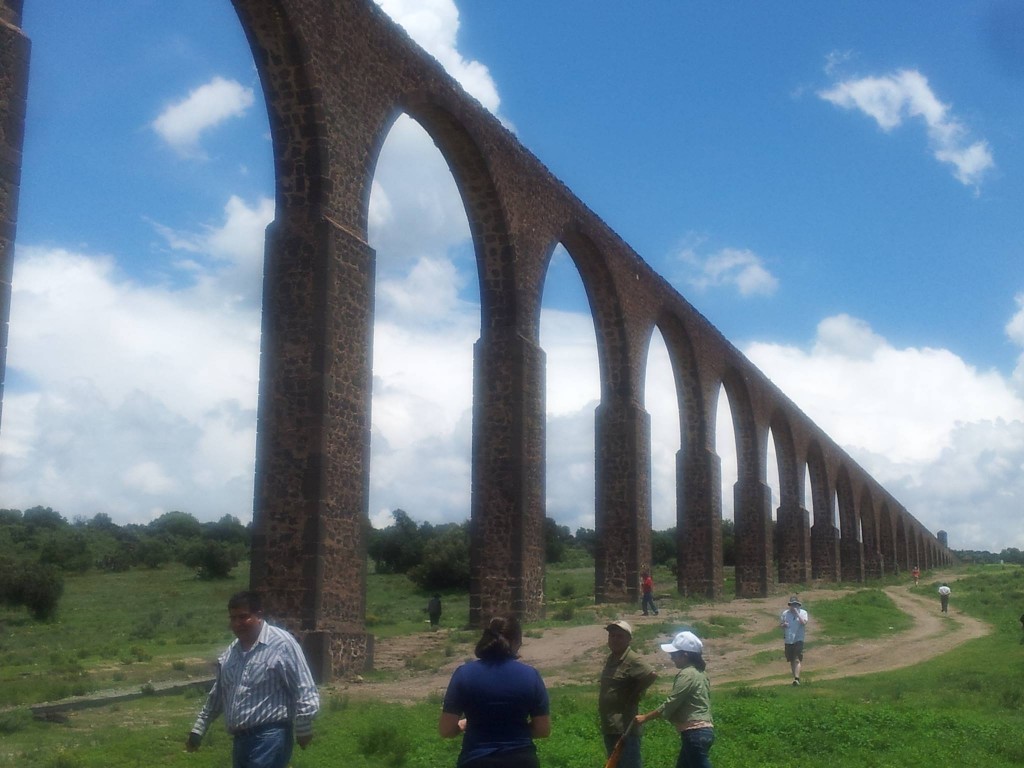Blog #9 – July 8, 2014
by Subi Azim and Kate Olson
The day started early with a layer of tiredness and sleepiness on everyone’s face. Most of us actually wanted to take a nap on our way to the field trip on the bus, but the bright sun broke through the heavy clouds and woke all of us up. The beautiful scenery of Mexico on the road, captured our attention kept us in high spirits.
Our first stop was a nopal farm. Nopal actually is cactus and is consumed by Mexicans as a type of vegetable and it is delicious. The farmer told us that in the 1990s he changed his  farm from Tuna (prickly pear) production to the current nopal farm because it was more profitable. He showed us how it is picked up from the field, how to manage the farm to make it resistant to diseases and make it more profitable. He also expressed his difficulties and frustration in directing the water to the farm and getting funds from the government to improve the necessary facilities. He has enough market for his own income, but the farmers need to form an association to increase the market scale. However, what broke our heart was, he earns next to nothing from every basket of nopal (he sells a basket of 200 nopals for 15 pesos).
farm from Tuna (prickly pear) production to the current nopal farm because it was more profitable. He showed us how it is picked up from the field, how to manage the farm to make it resistant to diseases and make it more profitable. He also expressed his difficulties and frustration in directing the water to the farm and getting funds from the government to improve the necessary facilities. He has enough market for his own income, but the farmers need to form an association to increase the market scale. However, what broke our heart was, he earns next to nothing from every basket of nopal (he sells a basket of 200 nopals for 15 pesos).
At this first stop we also saw La Bestia (the Beast—the train that many migrants ride to reach the Mexico-U.S. border). The train, however, was heading south and was void of any free-riders.
The second visit was to a farm who produces prickly pear fruits (known as tuna). At this
 site we saw how prickly this fruit actually is after it is picked and dried in the sun for a short amount of time and some of the group literally felt the sting from these thorns. We also saw examples of local innovation as the farmers decided they could have a better way to de-prickle the fruit. The machine they had seen would have to be imported and was very expensive. For this reason they talked to local welders and such specialists and they created a machine for a much cheaper price, and kept the production local. The peak production of the tuna is at one time of the year, whereas the nopal production is year round. We also had the opportunity to taste the three different types of prickly pear (tuna). Xoconostle (the bitter tuna fruit, a liquor is also made from this), as well as the green and red tuna, where green is the sweetest of them all.
site we saw how prickly this fruit actually is after it is picked and dried in the sun for a short amount of time and some of the group literally felt the sting from these thorns. We also saw examples of local innovation as the farmers decided they could have a better way to de-prickle the fruit. The machine they had seen would have to be imported and was very expensive. For this reason they talked to local welders and such specialists and they created a machine for a much cheaper price, and kept the production local. The peak production of the tuna is at one time of the year, whereas the nopal production is year round. We also had the opportunity to taste the three different types of prickly pear (tuna). Xoconostle (the bitter tuna fruit, a liquor is also made from this), as well as the green and red tuna, where green is the sweetest of them all.
Since we were running ahead of schedule after visiting the two cactus sites. We had a special treat to see the aqua-duct that this municipality is also famous for. This was a beautiful surprise!
Our last stop was a place where they produce mushrooms. They mainly make oyster mushrooms and we got a tour starting from the pasturisation of the barley straw to the actual growth of the mushrooms out of these plastic bags that holds the straw. This was  truly an example of innovation. It took the group of 7 three years to finally create a market niche and have some success with their production. It was a learning process and challenging because people thought they were crazy to produce mushrooms in the desert. But through community engagement (giving mushrooms as gifts and demonstrations in the community) they managed to convince people that these mushrooms could be used in their diet. Additionally, they also made some candies with the mushrooms that some of tried after our tour!
truly an example of innovation. It took the group of 7 three years to finally create a market niche and have some success with their production. It was a learning process and challenging because people thought they were crazy to produce mushrooms in the desert. But through community engagement (giving mushrooms as gifts and demonstrations in the community) they managed to convince people that these mushrooms could be used in their diet. Additionally, they also made some candies with the mushrooms that some of tried after our tour!
Dinner took place at the mushroom farm, where we had pure organic mushroom soup and delicious chicken wrapped with mushroom and other side dishes. The kind Mexican farmers impressed us with their good will and their kind heart. At the end of the day, we had an entertainment section, singing, dancing, laughter and local sweets made from nopal and the tuna (prickly pear and the xoconostle) became our dessert of the day~




